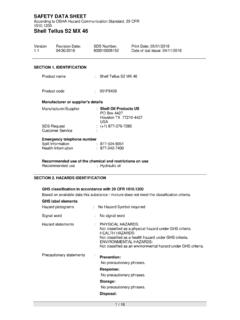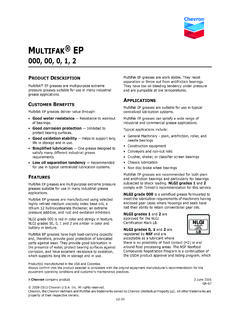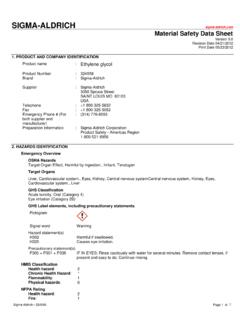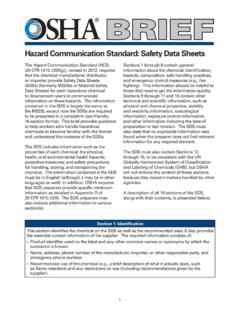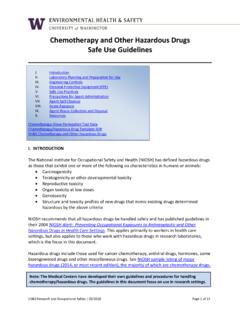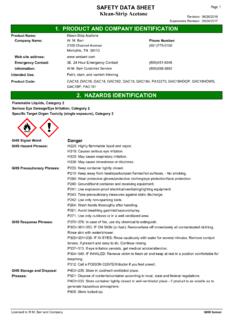Transcription of Shell Rotella T4 Triple Protection 15W-40 MSDS | SCL
1 SAFETY DATA SHEET According to OSHA Hazard Communication Standard, 29 CFR Shell Rotella T4 Triple Protection 15W-40 Version Revision Date: 04/30/2018 SDS Number: 800010026636 Print Date: 05/01/2018 Date of last issue: 05/11/2016 1 / 17 SECTION 1. IDENTIFICATION Product name : Shell Rotella T4 Triple Protection 15W-40 Product code : 001F8880 Manufacturer or supplier's details Manufacturer/Supplier : Shell Oil Products US PO Box 4427 Houston TX 77210-4427 USA SDS Request : (+1) 877-276-7285 Customer Service : Emergency telephone number Spill Information : 877-504-9351 Health Information : 877-242-7400 Recommended use of the chemical and restrictions on use Recommended use : Engine oil. SECTION 2. HAZARDS IDENTIFICATION GHS classification in accordance with 29 CFR Based on available data this substance / mixture does not meet the classification criteria. GHS label elements Hazard pictograms : No Hazard Symbol required Signal word : No signal word Hazard statements : PHYSICAL HAZARDS: Not classified as a physical hazard under GHS criteria.
2 HEALTH HAZARDS: Not classified as a health hazard under GHS criteria. ENVIRONMENTAL HAZARDS: Not classified as an environmental hazard under GHS criteria. Precautionary statements : Prevention: No precautionary phrases. Response: No precautionary phrases. Storage: No precautionary phrases. Disposal: SAFETY DATA SHEET According to OSHA Hazard Communication Standard, 29 CFR Shell Rotella T4 Triple Protection 15W-40 Version Revision Date: 04/30/2018 SDS Number: 800010026636 Print Date: 05/01/2018 Date of last issue: 05/11/2016 2 / 17 No precautionary phrases. Other hazards which do not result in classification Prolonged or repeated skin contact without proper cleaning can clog the pores of the skin result-ing in disorders such as oil acne/folliculitis. Used oil may contain harmful impurities. Not classified as flammable but will burn. The classification of this material is based on OSHA HCS 2012 criteria. Under normal conditions of use or in a foreseeable emergency, this product does not meet the definition of a hazardous chemical when evaluated according to the OSHA Hazard Communica-tion Standard, 29 CFR SECTION 3.
3 COMPOSITION/INFORMATION ON INGREDIENTS Chemical nature : Highly refined mineral oils and additives. The highly refined mineral oil contains <3% (w/w) DMSO-extract, according to IP346. * contains one or more of the following CAS-numbers: 64742-53-6, 64742-54-7, 64742-55-8, 64742-56-9, 64742-65-0, 68037-01-4, 72623-86-0, 72623-87-1, 8042-47-5, 848301-69-9. Hazardous components Chemical name Synonyms CAS-No. Concentration (% w/w) Alkaryl amine bis(nonylphenyl)amine 36878-20-3 1 - 3 Calcium sulphonate Benzenesul-fonic acid, mono-C16-24-alkyl derivs., calcium salts 70024-69-0 - Alkyl borate Not Assigned - Dialkyl alkaryl ami-nomethyl dicarbox-ylate Not Assigned - Alcohol, ethoxylated Alcohols, C12-16, ethoxylated 68551-12-2 - Interchangeable low viscosity base oil (<20,5 cSt @40 C) * Not Assigned 0 - 90 SECTION 4. FIRST-AID MEASURES If inhaled : No treatment necessary under normal conditions of use. If symptoms persist, obtain medical advice.
4 In case of skin contact : Remove contaminated clothing. Flush exposed area with wa-ter and follow by washing with soap if available. If persistent irritation occurs, obtain medical attention. SAFETY DATA SHEET According to OSHA Hazard Communication Standard, 29 CFR Shell Rotella T4 Triple Protection 15W-40 Version Revision Date: 04/30/2018 SDS Number: 800010026636 Print Date: 05/01/2018 Date of last issue: 05/11/2016 3 / 17 In case of eye contact : Flush eye with copious quantities of water. Remove contact lenses, if present and easy to do. Continue rinsing. If persistent irritation occurs, obtain medical attention. If swallowed : In general no treatment is necessary unless large quantities are swallowed, however, get medical advice. Most important symptoms and effects, both acute and delayed : Oil acne/folliculitis signs and symptoms may include formation of black pustules and spots on the skin of exposed areas. Ingestion may result in nausea, vomiting and/or diarrhoea.
5 Protection of first-aiders : When administering first aid, ensure that you are wearing the appropriate personal protective equipment according to the incident, injury and surroundings. Indication of any immediate medical attention and special treatment needed : Treat symptomatically. SECTION 5. FIRE-FIGHTING MEASURES Suitable extinguishing media : Foam, water spray or fog. Dry chemical powder, carbon diox-ide, sand or earth may be used for small fires only. Unsuitable extinguishing media : Do not use water in a jet. Specific hazards during fire-fighting : Hazardous combustion products may include: A complex mixture of airborne solid and liquid particulates and gases (smoke). Carbon monoxide may be evolved if incomplete combustion occurs. Unidentified organic and inorganic compounds. Specific extinguishing meth-ods : Use extinguishing measures that are appropriate to local cir-cumstances and the surrounding environment. Special protective equipment for firefighters : Proper protective equipment including chemical resistant gloves are to be worn; chemical resistant suit is indicated if large contact with spilled product is expected.
6 Self-Contained Breathing Apparatus must be worn when approaching a fire in a confined space. Select fire fighter's clothing approved to relevant Standards ( Europe: EN469). SECTION 6. ACCIDENTAL RELEASE MEASURES Personal precautions, protec-tive equipment and emer-gency procedures : Avoid contact with skin and eyes. SAFETY DATA SHEET According to OSHA Hazard Communication Standard, 29 CFR Shell Rotella T4 Triple Protection 15W-40 Version Revision Date: 04/30/2018 SDS Number: 800010026636 Print Date: 05/01/2018 Date of last issue: 05/11/2016 4 / 17 Environmental precautions : Use appropriate containment to avoid environmental contami-nation. Prevent from spreading or entering drains, ditches or rivers by using sand, earth, or other appropriate barriers. Local authorities should be advised if significant spillages cannot be contained. Methods and materials for containment and cleaning up : Slippery when spilt. Avoid accidents, clean up immediately.
7 Prevent from spreading by making a barrier with sand, earth or other containment material. Reclaim liquid directly or in an absorbent. Soak up residue with an absorbent such as clay, sand or other suitable material and dispose of properly. Additional advice : For guidance on selection of personal protective equipment see Chapter 8 of this Safety Data Sheet. For guidance on disposal of spilled material see Chapter 13 of this Safety Data Sheet. SECTION 7. HANDLING AND STORAGE Technical measures : Use local exhaust ventilation if there is risk of inhalation of vapours, mists or aerosols. Use the information in this data sheet as input to a risk as-sessment of local circumstances to help determine appropri-ate controls for safe handling, storage and disposal of this material. Advice on safe handling : Avoid prolonged or repeated contact with skin. Avoid inhaling vapour and/or mists. When handling product in drums, safety footwear should be worn and proper handling equipment should be used.
8 Properly dispose of any contaminated rags or cleaning mate-rials in order to prevent fires. Avoidance of contact : Strong oxidising agents. Product Transfer : This material has the potential to be a static accumulator. Proper grounding and bonding procedures should be used during all bulk transfer operations. Further information on stor-age stability : Keep container tightly closed and in a cool, well-ventilated place. Use properly labeled and closable containers. Store at ambient temperature. Packaging material : Suitable material: For containers or container linings, use mild steel or high density polyethylene. Unsuitable material: PVC. SAFETY DATA SHEET According to OSHA Hazard Communication Standard, 29 CFR Shell Rotella T4 Triple Protection 15W-40 Version Revision Date: 04/30/2018 SDS Number: 800010026636 Print Date: 05/01/2018 Date of last issue: 05/11/2016 5 / 17 Container Advice : Polyethylene containers should not be exposed to high tem-peratures because of possible risk of distortion.
9 SECTION 8. EXPOSURE CONTROLS AND PERSONAL Protection Components with workplace control parameters Components CAS-No. Value type (Form of exposure) Control parame-ters / Permissible concentration Basis Oil mist, mineral Not Assigned TWA (Mist) 5 mg/m3 OSHA Z-1 Oil mist, mineral TWA (Inhal-able fraction) 5 mg/m3 ACGIH Biological occupational exposure limits No biological limit allocated. Monitoring Methods Monitoring of the concentration of substances in the breathing zone of workers or in the general workplace may be required to confirm compliance with an OEL and adequacy of exposure con-trols. For some substances biological monitoring may also be appropriate. Validated exposure measurement methods should be applied by a competent person and sam-ples analysed by an accredited laboratory. Examples of sources of recommended exposure measurement methods are given below or con-tact the supplier. Further national methods may be available. National Institute of Occupational Safety and Health (NIOSH), USA: Manual of Analytical Meth-ods Occupational Safety and Health Administration (OSHA), USA: Sampling and Analytical Methods Health and Safety Executive (HSE), UK: Methods for the Determination of Hazardous Substanc-es Institut f r Arbeitsschutz Deutschen Gesetzlichen Unfallversicherung (IFA) , Germany L'Institut National de Recherche et de Securit , (INRS), France Engineering measures : The level of Protection and types of controls necessary will vary depending upon potential exposure conditions.
10 Select controls based on a risk assessment of local circumstances. Appropriate measures include: Adequate ventilation to control airborne concentrations. Where material is heated, sprayed or mist formed, there is greater potential for airborne concentrations to be generated. General Information: Define procedures for safe handling and maintenance of controls. Educate and train workers in the hazards and control measures relevant to normal activities associated with this product. SAFETY DATA SHEET According to OSHA Hazard Communication Standard, 29 CFR Shell Rotella T4 Triple Protection 15W-40 Version Revision Date: 04/30/2018 SDS Number: 800010026636 Print Date: 05/01/2018 Date of last issue: 05/11/2016 6 / 17 Ensure appropriate selection, testing and maintenance of equipment used to control exposure, personal protective equipment, local exhaust ventilation. Drain down system prior to equipment break-in or mainte-nance. Retain drain downs in sealed storage pending disposal or subsequent recycle.
